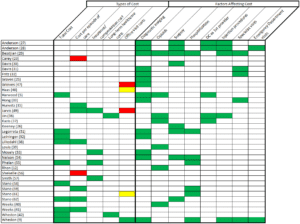By Zachary Cupler, DC, Alyssa Troutner, DC, Clinton Daniels, DC
Most chiropractors are very familiar with the fact that spine pain is a leading cause of disability worldwide.1 Not surprisingly, neck and low back pain care cost billions of dollars every year in the U.S.2 Patients with spinal pain have multiple options when choosing healthcare providers, which results in variable utilization of services and increased expenditure. A recent systematic review by Farabaugh et al., featured in Chiropractic & Manual Therapies, reported evidence that underscored the value of chiropractic care for patients experiencing spine pain if they consulted a chiropractor as their initial provider.3
The authors summarized and evaluated the evidence for the cost of chiropractic care compared to conventional medical care for the management of spine-related musculoskeletal pain. Over 2,200 papers were screened and 44 papers were evaluated as part of the study. There has been a rapid increase in the number of studies investigating chiropractic costs. For example, in the most recent five years (2018-2022), there was increased interest in cost studies with almost three articles per year published compared to only one paper per year in the span of 26 years (1991-2017).
Farabaugh et al. identified that individuals who initially sought treatment from a chiropractor saw a significant reduction in healthcare costs compared to those under medical management alone. Irrespective of the patient population, when a chiropractor was involved in patient care, diagnostic imaging, opioid utilization, surgery, hospitalizations, injection procedures, specialist visits, and emergency department visits were all reduced. The recurrent theme of the data suggested utilization of chiropractors as the first provider for an episode of spine pain results in lower costs and lower utilization of healthcare services.

Table 5. Association of chiropractic care with factors affecting costs, by study3
Green = chiropractic associated with either lower cost OR lower utilization
Yellow = cost OR utilization did not significantly differ between groups
Red = chiropractic associated either higher cost OR higher utilization
White = study did not evaluate this cost type OR utilization
Study authors provided the recommendation that, “…it may be in society’s best interest for U.S. healthcare organizations and governmental agencies to consider modifying benefit designs to reduce barriers to access to chiropractic providers.” While further research is needed, these exciting findings prompt a reconsideration of healthcare policies and benefit designs.
The authors went on to suggest that current third-party payer restrictions in the U.S. should be revised to improve access to chiropractic care, including considering modifying or eliminating preauthorization requirements, medical doctor gatekeepers, arbitrary visit limits, co-pays and deductibles. Given the growing recognition of chiropractic care’s role in the medical landscape, it is increasingly evident that chiropractors integrated into healthcare teams could yield substantial financial savings for patients and healthcare systems. To align with the evolving trends in healthcare, it may be advantageous for U.S. healthcare organizations and governmental agencies to explore avenues for reducing barriers to accessing chiropractic services. By embracing this shift, we can enhance patient outcomes while optimizing healthcare expenditure for the management of musculoskeletal pain.
This paper is available open access (for free) on the journal website: CLICK HERE
This work was supported in part by the Clinical Compass and the NCMIC Foundation.
Clinical Compass is a chiropractic clinical and research collaborative that generates best practices research through consensus-based models. In addition, Clinical Compass maintains regularly updated evidence centers for 17 different clinical topics such as dry needling, opioids, and cost-effectiveness. Learn how you can support the work of Clinical Compass.
Citations:
- Global Burden of Disease 2019 Diseases and Injuries Collaborators. Global burden of 369 diseases and injuries in 204 countries and territories, 1990–2019: a systematic analysis for the Global Burden of Disease Study 2019. Lancet (London, England). 2020;396(10258):1204–22.
- Dieleman JL, Cao J, Chapin A, Chen C, Li Z, Liu A, et al. US health care spending by payer and health condition, 1996–2016. JAMA. 2020;323(9):863–84.
- Farabaugh R, Hawk C, Taylor D, Daniels C, Noll C, Schneider M, McGowan J, Whalen W, Wilcox R, Sarnat R, Suiter L, Whedon J. Cost of chiropractic versus medical management of adults with spine-related musculoskeletal pain: a systematic review. Chiropr Man Therap. 2024 Mar 6;32(1):8. doi: 10.1186/s12998-024-00533-4. PMID: 38448998; PMCID: PMC10918856.
